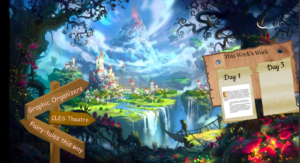For this particular assignment, we were sent on a scavenger hunt! It was kind of fun to dig around, and as usual, I was not content to sift through the provided resources, so dug up some really neat stuff…
When we first headed into pandemic teaching last spring, I packaged up a program that examined the elements of fairy tales with my grade 4 and 5 class. Amongst our goals, reading, responding, and making connections to text, and comparing and contrasting variations in format due to regionalization and diverse culture. In this exercise, I am extending the existing unit to more

Active link to our Fairytale Portal
fully include indigenous resources and perspectives. I will adjust the learning outcome accordingly to reflect the new addition.
Learning Outcome
By the end of this unit, students will be able to identify at least two literary elements contained in a fairy tale structure, and provide an example in both an indigenous and another culture. (Grade 5 Language Arts, BC Curriculum)
OER Number one
https://indigenousstorybooks.ca/about/resources/
This first resource matches quite nicely with both my topic and my level. Though the quantity of tales available is somewhat limited, the ethical and cultural use of these is on point, due to the curation and collaboration through the various First Nations. As such, the quality of the site is great, considering that there is a scarcity of resources of this caliber, and of this nature. I would use this as-is, as that too is ethically appropriate, but I would definitely pick and choose a large spread of resources in order to demonstrate the diversity between individualized nations.
Pros
- Indigenous compiled website, through the University of British Columbia, so culturally vetted.
- Free (as is to be expected).
- Reliable host, so longevity is not an issue.
- Well organized, according to indigenous groups.
- Local BC and Canadian focus, so relevant.
- Portal to international groups, so easily extended.
Cons
- Some stories are not, but are rather links to other resources, so becomes a bit of a rabbit hole
- Certain links are not well populated, for example, Interior Salish only has a single short film.
- Many groups are not represented outside of the coastal nations.
OER Number Two
https://www.oercommons.org/browse?f.keyword=fairytales
So often, when we see resources posted, they are touted as excellent avenues to enhancing student learning. However, this is an example of when resources fail to meet our expectations. Despite the fact that both of the next resources share a common URL, they are very dissimilar. Although I originally believed that this site’s contents closely matched my topic and level, I was very disappointed to note that although it was soundly constructed, the site appears to be short on content. Considering this, I would say the quality of the resource, though professional in appearance, is substandard as it does not supply the depth of content necessary to enhance my learning goal. I would be happy to take the one story from this, because it is in a usable format that I can easily modify, but beyond that, I find this site quickly and easily discarded. In fact, I would simply take the document, and probably never visit it again. (Incidentally, if you are looking for a vast repository of public domain fairy tales, try this site . Adaptations, of course, would need to be made for contextual and era-specific languages.)
Pros
- Public domain, so free cost.
- Available in a .doc format, so it is easy to adapt.
- Clearly organized website, and easy to navigate.
- Has accompanied rating system, so resources can be reviewed and ranked.
Cons
- Grossly underpopulated; there is only a single story resource available on the site.
- The search results were only loosely related to my initial search parameters.
OER Number Three
https://www.oercommons.org/browse?f.keyword=fairy-tales
I think it’s only fair to allow for some redemption, so once more we revisit the OER common site, but this time in pursuit of lesson plans or activities to supplement our unit. Despite its poor story bank, the site boasts a fairly in-depth set of individualized lesson plans that match perfectly with our topic. In terms of level, that is entirely dependent on class; each lesson plan comes with a suggested grade level. Of course, many of the resources listed are easily adopted in terms of lessening the demand for output, or reducing the number of steps for groups that struggle. I particularly like this site because the quality of the resources seems reasonable at first glance, but I really appreciate the review system that is in place , allowing one to see what others favoured or disliked at a quick glance.
Pros
- Public domain, so free cost.
- Available in a .doc format, so it is easy to adapt.
- Clearly organized website, and easy to navigate.
- Has accompanied rating system, so resources can be reviewed and ranked.
- Plenty of diverse resources that also cite the source.
- Grade level cited.
Cons
- Not all resources are reviewed, nor are there comments.
- There is no specified BC curriculum connection.
- Specific grade level is contained within the site link, but not viewable from search results.
- Not searchable/ able to filter by grade level.


Leave a Reply
You must be logged in to post a comment.